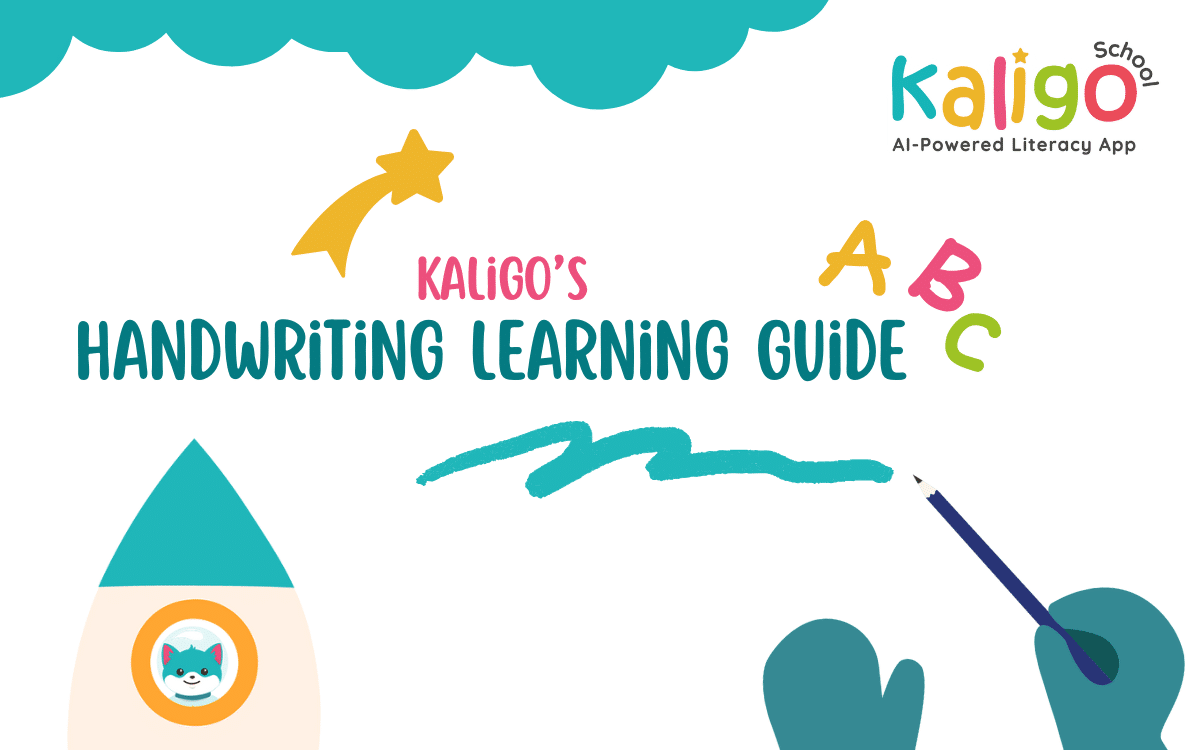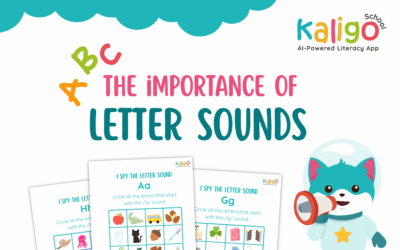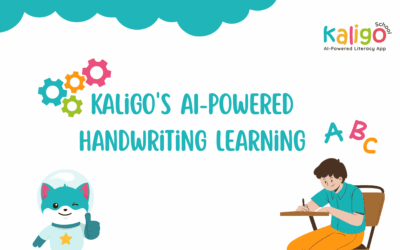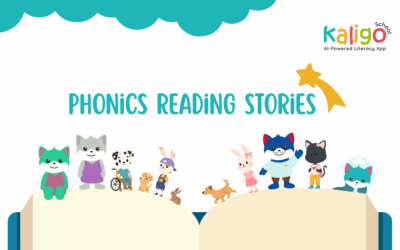Learning to write is a central milestone in a child’s educational development and begins as early as nursery. Writing is not only about putting letters on a page. It is a complex cognitive, motor and linguistic challenge that underpins later academic success. This learning journey does not happen overnight, it unfolds over several stages, each requiring specific skills and repeated practice.
Before children can write full sentences, they first explore the basics of letter formation, recognition, and imitation. They start by drawing, scribbling, and experimenting with mark-making, which lays the foundation for handwriting. Educational learning solutions like Kaligo provide age-appropriate activities for each stage, enabling gradual, child-friendly progress. This adapts to the individual learning pace of each pupil. Kaligo’s Handwriting Learning Guide highlights the importance of handwriting for children’s development and explains how Kaligo effectively supports early writing skills.
Learn to Write: Step by Step
Handwriting is a complex skill that takes years of consistent practice to master. Writing does not develop on its own. It is a skill children must learn it step by step, gradually building the physical, cognitive, and visual skills required.
These skills include fine motor development, visual letter memory, hand–eye coordination, and the ability to organise movements in space. Without these, writing fluently and legibly is extremely difficult. This process starts in nursery and continues through Key Stage 1. It often presents many challenges as children adapt to formal learning routines, navigate pencil grip, and experiment with letter formation. It is a journey that requires patience, practice, and targeted support from educators who understand the developmental stages of handwriting.
Why Learning to Write is a Complex Process
Writing involves the coordination of motor, visual, and linguistic skills simultaneously. It makes it one of the most intricate tasks the brain undertakes (Bara & Gentaz, 2010; Feder et al., 2007). It often takes several years for children to achieve fluent and accurate handwriting.
Early development of graphomotor skills not only improves writing, but also frees cognitive resources. This allows children to focus on higher-order thinking, problem-solving, and other intellectual tasks. For example, a child with well-developed fine motor skills can concentrate on the content of their writing rather than struggling to form letters. Handwriting is therefore much more than a mechanical skill, it is also deeply intertwined with broader cognitive development.
Graphomotor Skills as The Foundation of Handwriting
Graphomotor skills are considered as the cornerstone of handwriting development. They involve forming letters correctly, stabilising movements, and executing them fluently and confidently. Strong graphomotor skills positively impact spelling, writing fluency, and the ability to compose text accurately (Pontart et al., 2013).
Children who develop these skills early are better prepared for complex tasks. This tasks can be writing sentences and organising ideas on the page for instance. Graphomotor development also fosters concentration and patience, as children must control the fine movements of their fingers, hands, and arms in coordination. Effective handwriting is therefore the result of both physical dexterity and cognitive planning, integrated over time.
The Basics: Letter Recognition and Coordination
Learning to write relies on two critical abilities:
- First, children must recognise letters visually and connect them to their corresponding sounds.
- Second, they need to coordinate their hand movements to reproduce these letters accurately.
Both skills are essential to meet EYFS expectations, which encourage familiarity with print, capital letters, and cursive writing.
At the early stages, many children struggle to combine these skills. This explains why repeated practice and gradual introduction of letters are necessary (Karlsdottir & Stefansson, 2022). Research also shows that letter knowledge is one of the strongest predictors of later reading and writing success (Biot-Chevrier, Ecalle & Magnan, 2008). Writing requires precise motor coordination to form small, controlled movements. These help recalling each letter, planning the stroke, and executing it accurately (Bara & Gentaz, 2010). By around age 10, children typically begin to coordinate spatial positioning and stroke paths efficiently. This allows faster, more fluid writing (Chartrel & Vinter, 2006; Danna & Velay, 2015).
Before children can form letters, they explore drawing, scribbling, and imitation of writing, gradually gaining control of their movements. Even in primary school, some still find it challenging to form letters consistently (Bonneton-Botté & De La Haye, 2009). Writing involves the whole body, including shoulders, elbows, wrists, and hands. Fine motor control, demonstrating the physical complexity of this skill also come into play (Zesiger, 2003). Handwriting development is closely linked to overall motor development, making targeted exercises in the classroom essential to support progress (Lurçat, 1974).
Developing Graphomotor Skills
A crucial step often overlooked in early writing instruction is building hand and finger strength. This provides the foundation for effective pencil control. Children need the physical capacity to hold a pencil properly, yet this step is sometimes skipped. Modelling clay is an effective and playful way to develop these muscles, as children naturally strengthen their hands and fingers while kneading, pressing, and shaping the clay. This activity can be easily integrated into classroom routines and combined with EYFS goals, allowing children to explore shapes, materials, and vocabulary as they describe their creations.
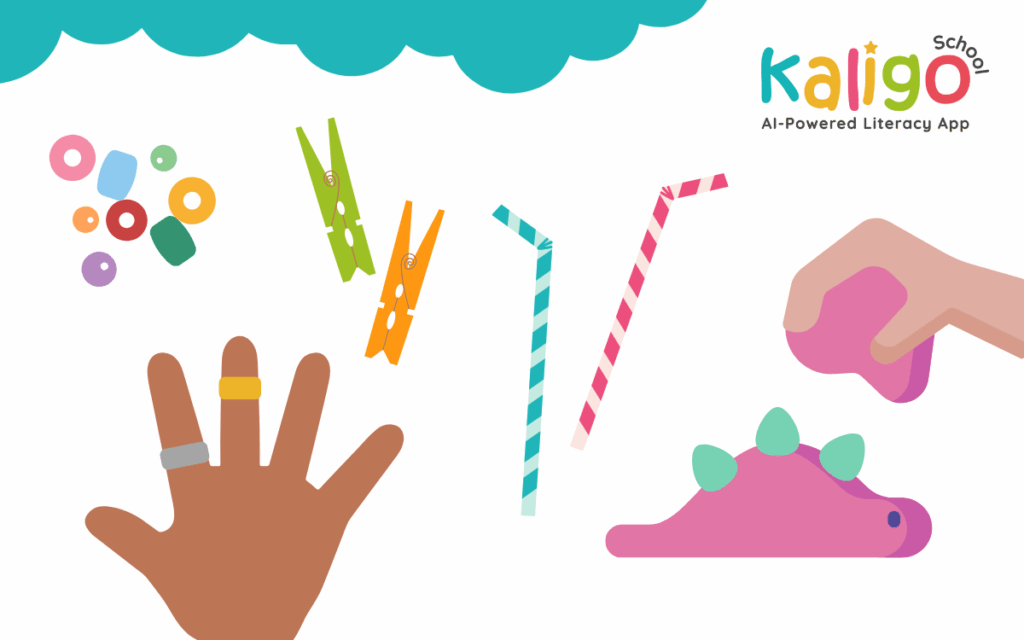
Flexibility and independence of finger movement are also vital. Simple exercises, such as finger rhymes, “piano” movements on the table, and individual finger stretches, can be incorporated into daily classroom activities. Encouraging children to practise with both hands is important, as hand dominance is still developing. For pupils who struggle with finger independence, acupressure rings can provide sensory stimulation. This helps children develop awareness of each finger and strengthen coordination for writing.
To refine fine motor control and improve precision, children can engage in playful activities such as transferring small objects with tweezers, threading beads, opening and closing jars, or using peg clips to connect items. These exercises strengthen dexterity, build endurance, and directly support the development of controlled, accurate letter formation and fluent handwriting.
From Graphomotor Skills to Writing
Once children develop basic graphomotor skills, they can begin structured pre-writing activities. National guidelines emphasise moving from spontaneous movements to controlled, intentional ones, allowing children to draw and replicate specific shapes. Typically, children progress from vertical and horizontal lines to diagonal lines, zigzags, circles, loops, and dots.
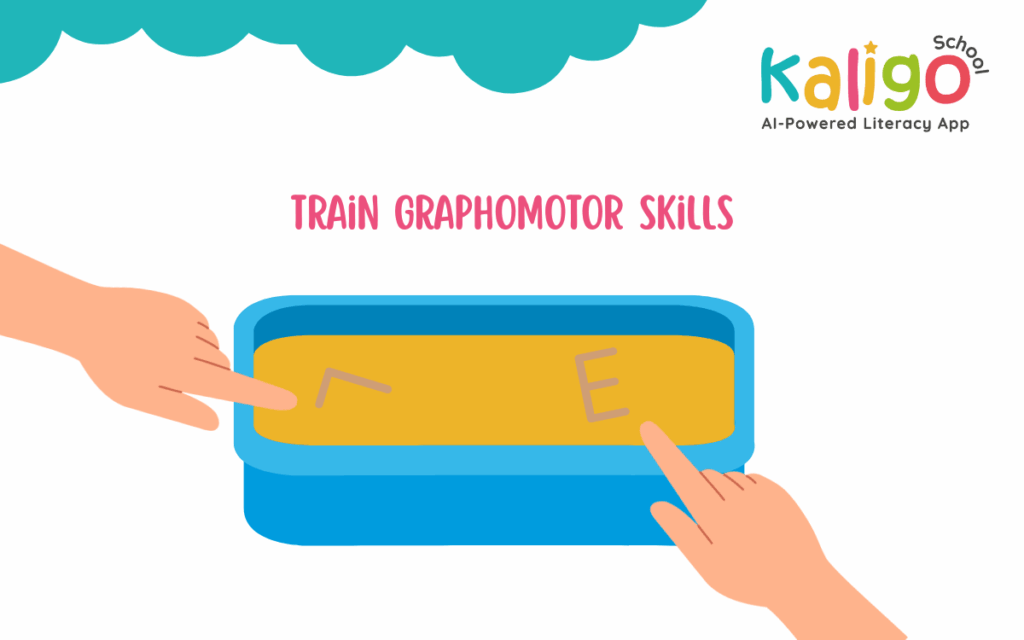
Using materials such as sand trays, rice trays, or finger paints allows them to trace and form shapes in a multisensory way. These approaches strengthen hand-eye coordination, increase engagement, and make learning enjoyable. By using a variety of materials, children remain curious and motivated, building confidence in their ability to control movements and shape letters accurately.
Learning Letter Forms
Children generally start with capital letters, practising them in a logical order: straight-lined letters first, followed by rounded letters, then slanted, combined, and finally complex letters such as S.
Initially, children observe the construction of letters, noting lines, curves, and strokes. They then practise tracing and forming letters using sensory approaches such as sand, flour, or finger paints, linking visual recognition with motor control. This stage develops awareness of letter shapes and builds confidence in forming letters independently with a pencil.
Learning the Correct Pencil Grip
Alongside letter formation, children learn to hold the pencil correctly. Teachers can model correct grip through demonstrations or videos, highlighting common mistakes. Kaligo offers interactive exercises to support correct pencil positioning, grip, and pressure control. These exercises ensure that children not only form letters accurately but also maintain comfortable posture and hand positioning, reducing fatigue and supporting long-term writing development.
All the information you need about pencil grip and good writing posture can be found (along with a little surprise) in our article dedicated to this topic.
Practising Handwriting
Handwriting development requires regular practice and repetition. Children progress from tracing, to copying, and finally to independent writing on paper, whiteboards, or digital devices. Consistent practice strengthens movement confidence, improves pressure control, and increases precision. Over time, these sessions foster both fine motor skills and writing fluency, laying a solid foundation for independent writing and academic success.
Learning to Write with Kaligo
Writing practice can also be enhanced through digital technology, and Kaligo provides a research-based, classroom-ready tool that complements traditional handwriting instruction. Kaligo delivers a multisensory, interactive experience, allowing teachers to observe and assess each child’s pencil grip, pressure, and stroke formation in real time. The platform provides immediate feedback, helping pupils correct mistakes as they occur, reinforcing proper habits, and building confidence in their handwriting.
Kaligo integrates evidence-based insights from motor skill and cognitive development research. The platform uses artificial intelligence to adapt activities to the progress of each child, offering a personalised learning journey that responds to individual needs. Whether a pupil struggles with letter formation, spacing, directionality, or pressure control, Kaligo tailors exercises to target areas that need reinforcement while skipping letters or skills already mastered.
Kaligo aligns with UK curriculum standards and the EYFS framework, offering activities that are multisensory and progressive. Children receive visual, auditory, and haptic feedback, making learning engaging and fun. Errors become learning opportunities, as the app provides gentle corrections and rewards progress with visual stars and achievements. Teachers also benefit from detailed analytics, tracking each child’s progress, identifying patterns of difficulty, and supporting individual learning plans or SEND interventions.
The platform can be used for guided handwriting sessions, independent practice, or homework, providing continuity between school and home. Children can work with a stylus or finger, ensuring accessibility for all learners. Beyond handwriting, Kaligo now includes modules for spelling, grammar, and sentence construction, allowing teachers to address literacy holistically while keeping children motivated through interactive, game-like activities. Kaligo is therefore not just a digital workbook; it also functions as a pedagogical assistant, saving teachers time, supporting differentiation, and reinforcing traditional teaching with adaptive, evidence-based technology. It ensures that children not only learn to write but also develop confidence, motivation, and enjoyment in literacy.
Tablets as a Motivational Tool
Digital learning has become a central focus in UK education, and tablets can play a highly effective role in literacy and handwriting development. When integrated with a structured pedagogical approach, technology not only motivates children but also increases engagement and focus (McKenna, 2015; Regenmorter, 2019). Teachers report that pupils are particularly enthusiastic when using tablets for reading and writing tasks, as the devices provide freedom, interactivity, and instant feedback.
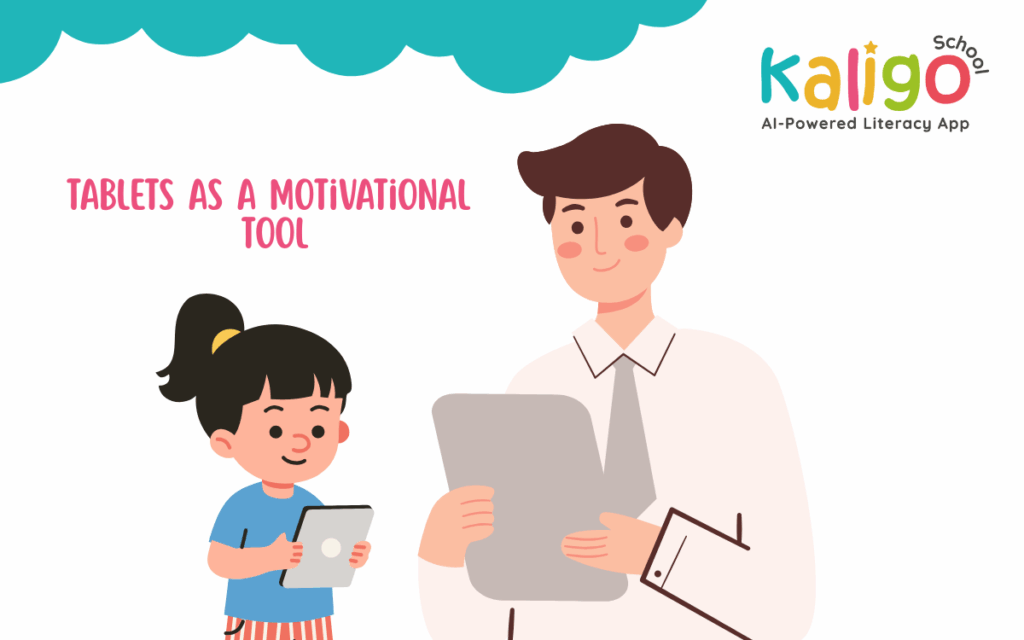
Tablets allow children to experiment, make mistakes, and correct them independently, which builds confidence and self-efficacy in writing. They also enable a multisensory approach: visual cues, tactile interaction, and auditory reinforcement work together to consolidate learning. While digital tools enhance motivation and interactivity, they complement rather than replace traditional handwriting instruction. Thoughtful integration ensures a balanced curriculum combining paper-based writing, physical exercises, and digital practice.
Even short daily or weekly sessions using tablets can significantly enhance progress. For example, a 10-minute guided digital activity can consolidate skills learned on paper, provide individualised challenges, and encourage practice outside the classroom. This approach ensures that technology enriches, rather than distracts from, core handwriting development. Our comprehensive approach to tablets in the classroom can be found in our article here.
Artificial Intelligence Supporting Writing
Kaligo’s artificial intelligence (AI) is a major advantage in supporting personalised handwriting development. Trained on thousands of children’s writing samples, the AI can detect common mistakes, including pencil lifts, incorrect stroke direction, letter order, and alignment with lines. It then adapts exercises to each child, creating a step-by-step, autonomous learning path.
This AI-driven approach offers two key benefits:
- First, children focus on letters or skills that challenge them most, avoiding repetition of skills already mastered. This reduces frustration, promotes confidence, and encourages progress at each child’s own pace.
- Second, the platform provides visual rewards, such as stars or green progress indicators, reinforcing motivation and helping children associate handwriting practice with success.
With the rise of AI tools like ChatGPT, artificial intelligence is no longer just futuristic, it has become a practical, classroom-ready tool. Kaligo has used AI for over a decade to support handwriting and literacy, helping teachers personalise instruction, track progress, and provide evidence-based interventions. Dashboards give insights into strengths, areas for improvement, and error patterns, supporting individual learning plans, interventions, and assessment.
A Library of Ready-to-Use Lessons
Kaligo offers a comprehensive library of ready-to-use learning units, called the Kaligo Library. Developed by teachers, special educators, and health professionals, these modules provide curriculum-aligned, high-quality resources that save preparation time while supporting differentiation.
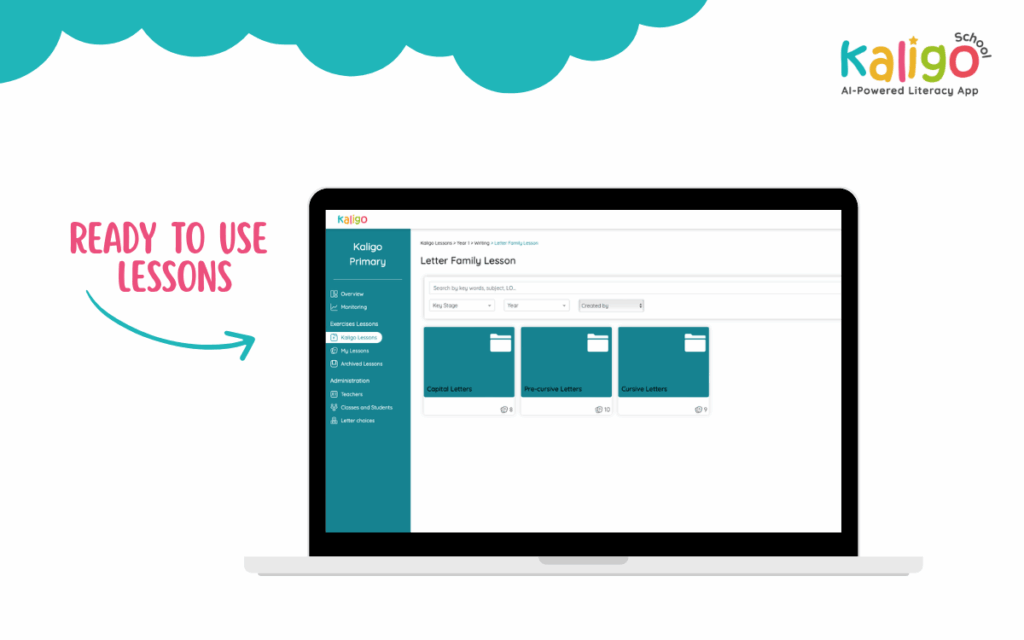
Teachers can customise lessons to the needs of individual pupils or the whole class, targeting challenges such as letter formation, stroke pressure, or fluency. Assignments can be given directly or adapted, ensuring consistent, progressive support across handwriting, spelling, grammar, and sentence construction. Integrating Kaligothek lessons into everyday teaching ensures that all pupils receive structured, personalised guidance.
Try Kaligo For Free
Kaligo now goes beyond handwriting, covering spelling, grammar, and sentence construction, allowing children to practise multiple literacy skills interactively. Teachers can try Kaligo for free by registering with an email address, with no obligation.
The platform is intuitive and easy to use, suitable for both classroom and home learning. Children can use a stylus or finger depending on the activity, while teachers monitor progress in real time. Tutorials, guides, and a chat function provide support, helping educators get the most out of the platform.
Kaligo is more than a digital tool, it is a comprehensive educational assistant. By combining evidence-based pedagogy, artificial intelligence, and interactive digital practice, it helps teachers save time, differentiate instruction, and provide high-quality, personalised handwriting support for every child. This integrated approach ensures that children not only learn to write but develop lifelong confidence and enjoyment in literacy.

